
Mali

Denominazione ufficiale: Repubblica del Mali
Official name: Republic of Mali
Nome nella lingua originale: République du Mali (fr) - Mali ka Fasojamana (bm)
Superficie: 1.240.142 km²
Popolazione: 14.517.176 ab. (2009)
Tipo di governo: Repubblica semipresidenziale
Capitale: Bamako
Moneta: Franco CFA
Lingue ufficiali: Francese
Nascita: Indipendenza dalla Francia nel 1960
Area: Africa
Fuso orario: UTC +0
Prima emissione: 1960
Ultima emissione: Attuale
Per saperne di più: http://it.wikipedia.org/wiki/Mali
Annotazioni: Ingresso nell'ONU 1960.
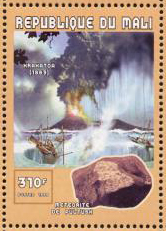
Soggetto: eruption of Krakatoa in 1883 Anno: 1999 Notizie: Krakatoa is an island volano located along the Indonesian volcano arc between the islands of Java and Sumatra. In 1883 Krakatoa erupted in one of the largest eruptions in modern times. The explosion was heard as far away as Rodriguez Island, over 4,600 km away. Ash fell on ships over 6,000 km to the west-northwest. Tsunamis towered as much as 40 meters above sea level, levelling everything in their path. Over 36,000 people lost their lives, and 165 coastal villages were destroyed. Over two-thirds of the original island of Krakatoa sank below the sea. Unusual atmospheric effects such as blue and green suns as well as exceptionally vivid red sunsets were observed world-wide because of the dust and aerosol particles injected by the eruption into the upper atmosphere. The temperature world-wide dropped by as much as 1.2 °C and did not return to normal until 1888. Krakatoa is paired with the Pultusk meteorite. A shower of meteorites totalling about 400 kg fell near Warsaw in Poland on January 30, 1868 at about seven o'clock in the evening. Thousands witnessed a bright fireball followed by the shower of tens of thousands of small stones from Pultusk to Nowy. Perhaps as many as 100,000 individual stones fell, but only a few thousand have so far been recovered. Pultusk is classified as a stony H5 chondrite. |
|---|

Soggetto: eruption of La Soufrière in 1902 Anno: 1999 Notizie: La Soufrière covers nearly one-third of the island of St. Vincent located at the southeastern edge of the Caribbean. There have been at least five major eruptions in historical times: in 1718, 1812, 1902, 1971, and 1979. The 1902 eruption occurred simultaneously with that of Pelée. The sheet shows the 1979 eruption which covered St. Vincent in ash. La Soufrière is paired with the Siena meteorite which fell near in Tuscany, Italy on June 16, 1794. Siena is classified as an LL5 chondrite. |
|---|

Soggetto: Etna 1986 Anno: 1999 Notizie: Mount Etna is located on the Eastern coast of Sicily in Italy. Etna is the highest active volcano in Europe. There are over two hundred subsidiary craters and cones all around the mountain. Etna has erupted over ninety times since the eighteenth century B.C. At least ten eruptions since 141 B.C. have caused fatalities. The sheet shows the eruptive activity of 1986. Mount Etna is paired with an etched and polished slice of the Tamentit iron meteorite revealing the Widmanstatten pattern. |
|---|
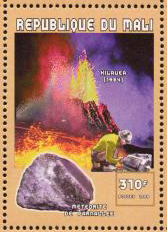
Soggetto: Kilauea 1984 Anno: 1999 Notizie: Kilauea in Hawaii is one of the most active volcanos in the world. Kilauea has been rift erupting almost continuously since 1983. The last summit eruption took place in 1982. The sheet shows the eruptive activity in 1984. Kilauea is paired with the Parnallee meteorite. Parnallee fell February 28, 1857 in Tamil Nadu, India. Two stones were found totalling about 78 kilograms. Parnallee is classified as an LL3 chondrite. |
|---|
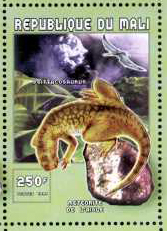
Soggetto: Pioggia di meteoriti Anno: 1999 Notizie: Psittacosaurus appears with a specimen of the L'Aigle meteorite shower. The L'Aigle shower fell April 26, 1803 in Orne, Normandy, France. Prior to this time European scientists viewed meteorite falls with skepticism, even when witnessed. The L'Aigle shower helped convince skeptics that rocks do fall from the sky. |
|---|
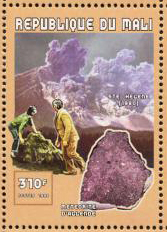
Soggetto: St Helens 1980 Anno: 1999 Notizie: Mount St. Helens is located in Washington state in the northwestern United States. Mount St. Helens erupted volently in 1980. The sudden removal of the volcano's northern flank by an avalanche released pent-up pressure in the interior of the volcano. The volcano erupted laterally to the north and devastated an area of almost 400 square kilometers. Mount St. Helens is paired with the Allende meteorite. A shower of stony meteorites fell on February 8, 1969 in the state of Chihuahua in northern Mexico. The meteorite fragments covered a large area of over 300 square kilometers. Allende is classified as a CV3 carbonaceous chondrite. Specimens of Allende preserve evidence of the earliest processes in the formation of the solar nebula from which the Earth and other planets were born. The calcium-aluminum inclusions found in Allende suggest an origin in pre-existing interstellar grains which mixed with the forming solar nebula. Hence these inclusions are older than the Earth itself. Allende also contains a new form of carbon called fullerene, a soccer-ball shaped molecule of sixty or more carbon atoms. Some scientists claim Allende contains fossilized microorganisms of possible extraterrestrial origin. |
|---|
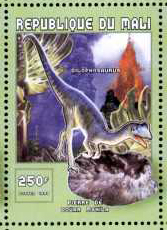
Soggetto: the Douar Mghila meteorite Anno: 1999 Notizie: Dilophosaurus appears with the Douar Mghila meteorite. This meteorite fell August 20, 1932 in Morocco. It is classified as an LL6 chondrite. |
|---|
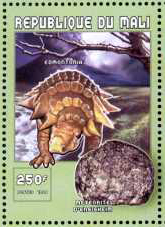
Soggetto: the Ensisheim meteorite Anno: 1999 Notizie: Edmontonia appears with the Ensisheim meteorite which fell in Alsace, France on November 16, 1492. The Austrian emperor Maximilian decided it was a sign from God predicting his victory in battle against the French. And indeed Maximilian's army defeated a much larger French force at the battle of Salins. The meteorite probably received as much credit for the victory as Maximilian. Ensisheim is the second or third oldest witnessed meteorite fall for which any of the original meteorite survives and is definitely known to come from the fall. The oldest is a Japanese fall of May 19, 861. The second oldest may be Elbogen from what is now the Czech Republic. Some believe the extant specimens of Elbogen come from an observed fall in 1400. The remaining main mass of Ensisheim is still preserved in the church in Ensisheim where Maximilian ordered it kept. Ensisheim is classified as an LL6 stony chondrite. |
|---|

Soggetto: the eruption of Pelée Anno: 1999 Notizie: Pelée on the island of Martinique in the West Indies erupted violently in 1902. An incandescent high velocity cloud of ash, hot gases, and volcanic dust (a nué ardente ) completely destroyed the town of St. Pierre, killing all but three of the thirty thousand inhabitants. Pelée was the deadliest eruption of the twentieth century and probably the third most deadly of the past two thousand years. Pelée is paired with the Ouallen mateorite. This stony meteorite was found in Algeria in 1936. |
|---|
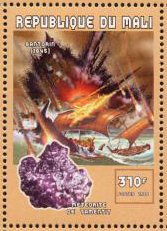
Soggetto: the eruption of Santorini Anno: 1999 Notizie: Santorini is a small Greek island in the middle of the Aegean Sea. The eruption of Santorini (Thera) around 1628 B.C. was among the largest in the past ten thousand years. Ash produced by Thera reached as far east as Turkey and as far south as Egypt. The sheet shows the comparatively mild eruption of 1645. Santorini is paired with the Tamentit meteorite. This iron meteorite was first reported in the West in 1865. It was found in Tamentit Oasis in the district of Touat in Algeria. The local Arabs venerated the meteorite and considered it their talisman. The main 510 kg mass now resides in the Muséum National d'Histoire Naturelle in Paris, France. |
|---|
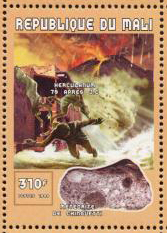
Soggetto: the eruption of Vesuvius in 79 AD Anno: 1999 Notizie: The most famous eruption of Mount Vesuvius in Italy took place in 79 A.D. This eruption buried the towns of Herculaneum and Pompeii. The sheet shows the lava inundating Herculaneum. Vesuvius is paired with the Chinguetti meteorite which was found in Mauritania in 1920. Chinguetti is a stony-iron mesosiderite. A Bedouin showed two French legionaires the location of a supposed giant meteorite as big as a house. Unfortunately the desert sands covered the meteorite. It remained lost until recently, when it was found again and determined to be just a large natural hematite formation. The meteorite fragments found nearby were unrelated to this formation. |
|---|

Soggetto: the Popocatépetl eruption of 1519 Anno: 1999 Notizie: Popocatépetl, which means "smoking mountain" in the Native American Nahuatl language, is located in south central Mexico in the state of Puebla. Over thirty six eruptions are known to have occurred within historical times. The sheet shows the ccc, the year the Spaniards arrived in Mexico. Cortez's army collected sulfur from the volcano to manufacture gunpowder to use in conquering the Aztecs. Popocatépetl remains an active volcano with moderate eruptions recorded as recently as April 2000. |
|---|

Soggetto: the Saint Mesmin meteorite Anno: 1999 Notizie: Deinonychus appears with a specimen of the Orgueil meteorite shower. Orgueil fell on May 14, 1864 in Montauban, Tarn-et-Garonne, France. Orgueil is classified as a CI carbonaceous chondrite, which means it may originate from a comet. Orgueil is famous because of claims that it contains tiny structures which resemble fossil algae. |
|---|

Soggetto: the Saint Mesmin meteorite Anno: 1999 Notizie: Carnosaurus appears with the Axtell meteorite. Axtell was found in 1943 in McLennon County, Texas, USA. Axtell is classified as a CV3 carbonaceous chondrite. |
|---|
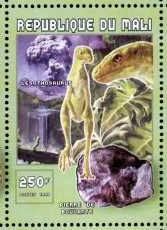
Soggetto: the Saint Mesmin meteorite Anno: 1999 Notizie: Lesothosaurus appears with the Bouvante meteorite. Bouvante was found July 30, 1978 in Drome, France. Bouvante is classified as a "Stannern Trend" Eucrite achondrite. This means it may be a fragment of the asteroid Vesta. |
|---|
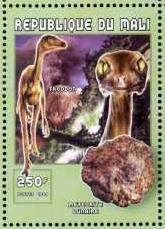
Soggetto: the Saint Mesmin meteorite Anno: 1999 Notizie: Troodon appears with a Lunar meteorite. Lunar meteorites were probably blasted off the Moon's surface by large impacts. |
|---|
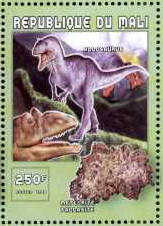
Soggetto: the Saint Mesmin meteorite Anno: 1999 Notizie: Allosaurus appears with a Pallasite meteorite. As noted above, Pallasites probably formed in the boundary layer between the iron core and the stony mantle of an asteroid. |
|---|
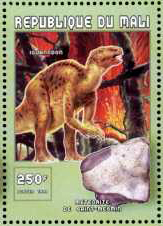
Soggetto: the Saint Mesmin meteorite Anno: 1999 Notizie: Iguanondon appears with the Saint Mesmin meteorite. Saint Mesmin fell May 30, 1866 in Aube, France. It is classified as an LL6 stony chondrite. |
|---|
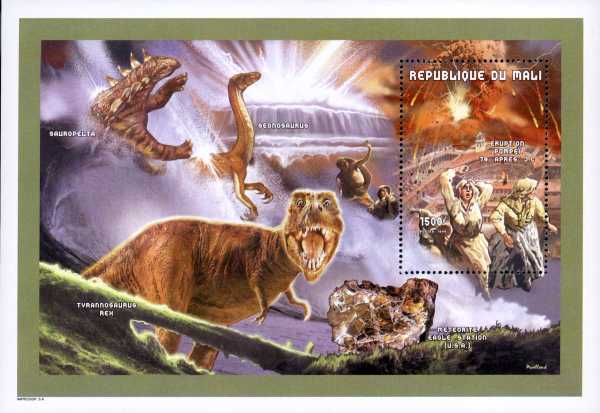
Soggetto: two terrestrial catastrophes Anno: 1999 Notizie: In 1999 Mali issued a miniature sheet depicting two terrestrial catastrophes. The catastrophe is the giant impact at the end of the Cretaceous. Three dinosaurs -- Sauropelta, Segnosaurus, and Tyrannosaurus rex -- are caught up in this disaster. The second catastrophe is the great Plinian eruption of Mount Vesuvius in 79 A.D. which buried the Roman cities of Herculaneum and Pompeii. Several people are shown trying to flee the eruption. At the bottom right appears the Eagle Station meteorite. Eagle Station was found in 1880 in Carroll County, Kentucky in the USA. Eagle Station is classified as a Pallasite. Pallasites are composed of olivine crystals set in a nickel-iron matrix. They probably formed in the boundary layer between the iron core and the stony mantle of an asteroid. Thin translucent slices of well-preserved Pallasites are very attractive and are used to create jewelry. |
|---|